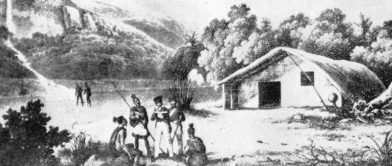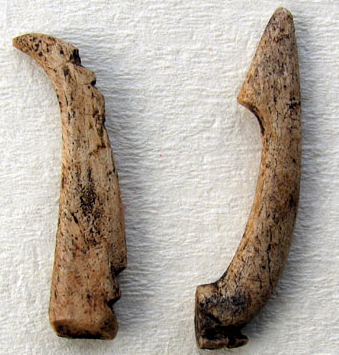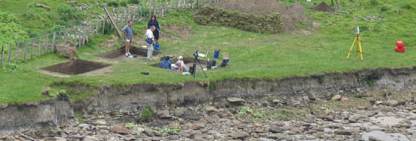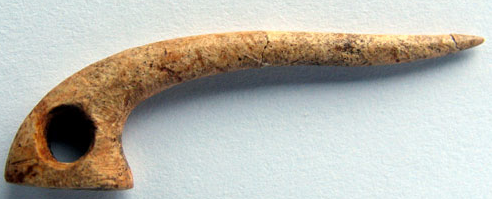Difference between revisions of "Cook's Cove"
| (One intermediate revision by the same user not shown) | |||
| Line 19: | Line 19: | ||
The archaeological excavation at Cook's Cove will salvage information from a site that is threatened by coastal erosion. The site is located on the southern bank of the river mouth at Cook's Cove. | The archaeological excavation at Cook's Cove will salvage information from a site that is threatened by coastal erosion. The site is located on the southern bank of the river mouth at Cook's Cove. | ||
| − | It is an early site, probably dating to the 14th or early 15th century AD, based on the types of artefacts and midden material visible along the exposed edge. The age can also be assumed due to the presence of Loisels Pumice, and this site was one of Harold Wellman's type sites for his 1962 publication Holocene of the North Island of New Zealand. | + | It is an early site, probably dating to the 14th or early 15th century AD, based on the types of artefacts and midden material visible along the exposed edge. The age can also be assumed due to the presence of Loisels Pumice, and this site was one of [[Wellman Harold|Harold Wellman's]] type sites for his 1962 publication Holocene of the North Island of New Zealand. |
Such sites are rare and because this site is currently being actively eroded by the sea a decision was made to carry out an excavation to retrieve valuable information prior to the total destruction of the site - an event that is not far off. | Such sites are rare and because this site is currently being actively eroded by the sea a decision was made to carry out an excavation to retrieve valuable information prior to the total destruction of the site - an event that is not far off. | ||
| Line 102: | Line 102: | ||
''Archaeology in New Zealand Vol. 47, New Zealand Archaeological Association, 2004'' | ''Archaeology in New Zealand Vol. 47, New Zealand Archaeological Association, 2004'' | ||
| − | + | ||
| + | [[Category:New Zealand Archaeology]] | ||
[[Category:East_Coast]][[Category:Prehistoric]] | [[Category:East_Coast]][[Category:Prehistoric]] | ||
Latest revision as of 09:06, 13 January 2013
Contents
History
Cook's Cove is named after the English explorer, Captain James Cook who arrived in the Tolaga Bay area in 1769. Cook and his crew were circumnavigating New Zealand in their vessel, the Endeavour, and spent some time in Cooks Cove (Opoutama). They dug a well and records kept indicate they were impressed with the Hole-in-the-Wall rock formation, near the cove.
The Tolaga Bay area had already been inhabited by Māori for many centuries. The main iwi (tribe) that lived at the Bay and used Cooks Cove for fishing and gathering other seafood was Te Aitanga a Hauiti.
Location of Cook's Cove Excavation
Cooks Cove is situated at the southern end of Tolaga Bay, 52 kilometers north of Gisborne and 2 kilometers south of Tolaga Bay township.
<googlemap lat="-38.281313" lon="178.033447" zoom="7"> -38.377757, 178.338881, Cook's Cove, New Zealand </googlemap>
Background of Cook's Cove Excavation
The archaeological excavation at Cook's Cove will salvage information from a site that is threatened by coastal erosion. The site is located on the southern bank of the river mouth at Cook's Cove.
It is an early site, probably dating to the 14th or early 15th century AD, based on the types of artefacts and midden material visible along the exposed edge. The age can also be assumed due to the presence of Loisels Pumice, and this site was one of Harold Wellman's type sites for his 1962 publication Holocene of the North Island of New Zealand.
Such sites are rare and because this site is currently being actively eroded by the sea a decision was made to carry out an excavation to retrieve valuable information prior to the total destruction of the site - an event that is not far off.
The work is being funded by the NZHPT, The University of Otago and the Gisborne Branch Committee of the NZHPT. It is being carried out in partnership with Te Aitanga a Hauiti. [1]
Goals of the Excavation
Targeted excavations on the site aimed to retrieve midden (prehistoric food remains), material culture and radiocarbon samples.
The midden will be used to reconstruct subsistence activities and some environmental information. The material culture will assist in defining site function and relationships with other early New Zealand sites. The radiocarbon samples will provide information on the exact age of the site.
Cook's Cove Excavation in Detail
The project took a total of eighteen days to complete, beginning on November 5, 2007 and ending on November 22, 2007.
Day 1
Cook's Cove is surrounded by farmland, so the surface of the archaeological site was covered with pasture and brush-like flora. The thistles were chopped out, and the turf was removed from the two areas to be excavated. The turf was cut out in squares, and was stacked at the edge of the site so that it can be replaced at the end of the excavation.
Immediately beneath the turf, archaeological soils were visible as a dark layer. About 20 cm below the surface, a layer of crushed shell with some whole Cook's Turban shells (Cookia sulcata) was encountered. Archaeologists excavate according to the stratigraphy of the site; here, the shell represents a distinct layer in the soil profile. The site directors decided that to begin with, the area should be excavated to the top of this layer. By the end of the first day of the excavation, the surface of the shell layer had been partially exposed.
Day 2
The areas were excavated in 1 x 1 m squares. As the squares were excavated, artefacts or bone were removed and placed into trays. Animal, bird and fish bones were recovered in addition to a quantity of artefacts.
Towards the end of the day a 50 cm wide trench was opened across the north end of one of the areas to determine the depth of the next layer of cultural material. From this trench it became apparent that there was approximately 50 cm of a sterile mixed soil and clay layer between the crushed shell layer.
(Days 3 and 4 were continuations of Day 2's plans)
Day 5
The team set to work in the three excavation areas (see site excavation map). The directors focused on surveying and mapping the landscape surrounding Cook's Cove with the theodolite and GPS. Loose soil was brushed off Area O12 and the baulks were tidied to make ready for photography.
Days 6 and 7
On Day 6, the excavation continued through Layer 5 in Area 012. Layer 5, at the Cooks Cove site, is a dark charcoal-stained soil with shell and some fish and bird bone. All of the midden from this layer was recovered by way of wet-sieving. The excavated material was placed in large sieves with a 4 mm mesh, taken to the edge of the sea, and shaken in the shallow water. All that remained in the sieve after this process was dried, bagged and retained for analysis.
In Area O11-west, Layer 4 was removed to expose the top of Layer 5.
On Day 7, heavy rain had fallen during the night which made the areas slightly muddy and only a minimal amount of excavation was carried out. This involved levelling the surface in Area O11-east and wet sieving and bagging the material recovered. Several other activities were carried out during the course of the day. A small group went foraging around the rocks about 100 m from the site and found a variety of marine foods which have all been discovered during the course of excavation.
Days 11, 12, 13
Moa phalanges (toe bones) and a tarsometarsus (bone of the lower leg) were uncovered in area O12. Moa, therefore, were being used as food as well as a raw material for the manufacture of fish hooks. This adds considerable weight to the argument that the site was occupied within the first 150 years of New Zealand's settlement.
Obsidian and chert flakes were more abundant as the excavation progressed further into Layer 5. Some of these had evidence of damage along the cutting edges - "use wear." Two more bone fishhooks have been recovered from area O11. Shell fish hooks, rare in New Zealand archaeological sites, were present. These artefacts were special because one piece fish hooks made of shell were usually only found in sites that post-date the extinction of moa.
Another team worked to establish the extent of the site by using an auger. An auger is a tool that is used to extract soil cores from many metres deep.
Cores were taken at 5 metre intervals at transects running east and south from the site. The soil that was taken up was examined to determine if it contained evidence of cultural material. This exercise revealed that the site extends roughly 25 metres to the south of the excavated areas.
Days 14, 15, 16
In O11 East, the stratigraphy towards the base of Layer 5 was different from the other areas in that it consisted entirely of umu or earth ovens. At least seven of these circular semi-subterranean features have been excavated.
Each of them was filled with charcoal fragments and fire cracked rocks. This indicated that this part of the site was a cooking area where cooking ovens were dug repeatedly over the course of the occupation. Over the next day and a half there was at least 150-200mm to excavate until the team reached the 'natural' crushed shell and beach sand layer.
In O12, the skeletal remains of a large sea mammal were in the process of being excavated. This was of interest because this area had contained the largest quantity of bones, which most likely represent food remains. It is also of interest because sea mammal and moa bones were often found together in early sites, before moa became extinct and sea mammal distributions shrunk, primarily due to hunting by Maori.
In the trench extending eastwards, Layer 5 was encountered at the western end of the trench. This appeared as a soil with charcoal and broken shell about 1.5 metres below the surface. The eastern edge of the site had not been clearly established, but it appeared to be about five to seven metres beyond the excavated areas.
Days 17 and 18
On the final days of excavation, artefacts were recovered from the lowest levels suggesting that stone-tool working also took place in the vicinity. Several stone files, that were probably used to polish and grind bone tools in the final stages of their production, were present. Hammer-stones, used for stone-flaking, were also recovered, as were large obsidian flakes and cores (from which flakes had been struck). Moa bones (including another tarsometatarsus) were present; which were concentrated in the southern end of the area.
In O11 east the team had been struggling down through the ovens - more than nine in total, one with a large posthole cut through it. To try and speed up the process the team resorted to using hoes and spades to carefully, but more quickly, remove the cultural material.
Features cut into the natural subsoil - like postholes and drains - often stand out very clearly once the bottom of the site was reached. This was the case in area O11 East: the very dark contents of several postholes and a possible drain contrasted markedly against the yellow natural beach gravel. This structural evidence was mapped, the features were half-sectioned, and the excavation was complete at last.
References
http://www.sha.org/default.cfm
http://www.historic.org.nz/ProtectingOurHeritage/Archaeology/ArchaelogicalInvestigations/CooksCove.aspx (Images gathered from the website above)
Archaeology in New Zealand Vol. 47, New Zealand Archaeological Association, 2004




